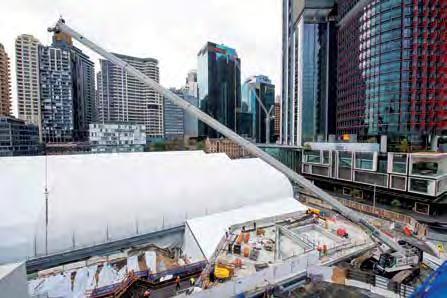
8 minute read
Melrose Cranes profile How to manage a growing fleet and the difference a Link Belt has made
LINK BELT ADDS DIVERSITY TO MELROSE FLEET
Melrose Cranes & Rigging is a family-owned Sydney company with brothers Gregg and Tony Melrose at the helm. Ensuring the crane fleet is contemporary and utilised to the maximum, for over 20 years, is a fair juggling act. Gregg Melrose provides the following insights into how he has managed to do just that.
PRIOR TO STARTING THE BUSINESS IN 1998, managing director Gregg cut his “crane teeth” at Wilson Mobile Cranes, a reputable family crane business back in the 80s and 90s.
“I learnt a lot about the crane business from ‘The Master’, Laurie Wilson,” said Melrose. “Laurie taught me a lot and many of his lessons have been implemented in this company along with the knowledge I learnt in my earlier, transport-based career, particularly in relation to maintenance. I’ve combined both sets of knowledge and turned them into a self-sufficient crane company. The same principles are also applied to our access division, Melrose Access Hire,” he said.
“This is our 21st year, and we’ve grown from one crane with a few subbies to a fleet of 50 plus cranes and staff of almost 140. Most of our staff are employees, but we do have a few sub-contractors in the workshop and specialist tradesmen, including boiler makers, mechanics, fitters, etc.”
Managing and accommodating the growth of the business has seen its challenges for Melrose.
The company has always had facilities in and around the Seven Hills area, but as the business grew, the demand for more space increased.
“Having occupied multiple premises and yards, we finally found a nearby location, bit the bullet, and moved into our new premises in May 2018,” he said.
“The new facility occupies 20,500sqm. We ripped down approximately 7000sqm of an old factory, maintained the façade and the office areas, then modified the workshop height to get booms in the air on rainy days.”
As the business has grown, so has the company’s capabilities.
“We’ve evolved from a general hire company to become a specific crane business focussed on the infrastructure construction program in and around Sydney,” said Melrose.
“We’re not exclusive – there are obviously other good crane companies in Sydney – but we would like to think we are in the top echelon. We are asked to quote on all major works, and we have excellent, long term relationships with some of the major construction businesses in Sydney. Clients include Lendlease, CPB, Laing O’Rourke, John Holland Group, Downer, Mirvac and Keller.
“So, we are well known across the Sydney metropolitan area. In days gone by, wind farm work was big for us as this was during a time when there wasn’t a suitable crane in every location. Now you see heavy cranes everywhere. That said, we are currently quoting to build a couple of wind farms in other states, which will mean the purchase of more and even larger capacity cranes,” he said.
According to Melrose, his crane fleet has changed and evolved to accommodate organic growth and natural attrition and to cover market requirements and customer needs.
“Probably the single biggest decision we made was to bring the 450t Grove into the fleet. Twelve years ago, this was the biggest road-going crane and it set the benchmark. We used to travel to Tasmania, South Australia, Victoria and Queensland and all over New South Wales. It was the biggest crane on the eastern seaboard for a few years, which really helped to kick our company along,” he said.
The GMK7450 is a heavy lift 450 tonner on 7 axles with a 60m boom and the first version of the Grove MegaWingLift (MWL) lifting enhancement.
“We now have many cranes in every capacity, including cranes that are offshore on dry hire. We have a great number of what I call ‘grunt cranes’, which are in the 70t to 150t class in mobiles along with crawlers as well.
“More recently, we invested in a Link Belt hydraulic crawler crane to diversify the fleet even further and this evolved into more mini cranes also. We now have every type of mini crane between 4t and 10t. The 10t UNIC is the largest mini crane in the world and is currently on site at the airport,” he said.
“We’ve had the Link Belt TCC 1400 for just over a year. It’s a great crane and we’re happy with the purchase. It’s so easy we have our own TRT heavy float and dolly combination to move it and we can put it together very quickly on site, given good access. With two B double units, the float and a driver and dogman, the crane is assembled in just over two hours and ready to work.
“Clients are impressed with its

Link Belt TCC 1400 impresses with boom length and compactness.

boom length, and its compact nature particularly suits a lot of jobs around Sydney. We’ve lifted it into holes to work and we’ve put it up side streets. Keller is a specific civil and piling contractor that uses it regularly. We’ll put it onto a site for a period of weeks for it to be set up in a hole and then pull it out again. It’s about to go to the central coast for another set of bridges and piling work, so it’s busy,” he said.
“It’s proving to be very popular, and my drivers love it. They find it simple to operate and it’s been a very reliable machine. It’s simple to maintain and the service from Ben and Anthony at Crane Connection has been second to none. It’s a great machine and we’re seriously considering buying one of their 220s or maybe another 127, depending on the workload over the next few months.”
According to Melrose, customer service is one major focus for the business.
“We focus on providing our customers with an excellent service and options in terms of crane selection, and we try to remain self-sufficient as a business. For example, we probably have more transport than most businesses. We run 20 prime movers and over 50 trailers, including B double combinations and floats with dollies. We like to be known as the company that turns up on time, every time, where and when we are needed. We try not to be reliant on sub-contractors; we use our own resources,” said Melrose.
However, as far as Melrose is concerned, traditional business values are the most important factor in his success with the business.
“I’ve never wanted the business to be too big. I have a great number of excellent managers and staff and that’s the key to the business: keeping and maintaining a high-quality team like ours. It’s the same with the crane fleet. You can have as many contracts as you want, but if you can’t service the client at a certain level there’s no point,” he said.
“I’ve always conducted business face to face, but I realise I can’t be everywhere, so I need very good people around me. I don’t think I’ll ever truly retire, but I plan to work a little less, so my son Ryan will take over the general business management and my younger brother Mick will manage business development. They share my philosophy. We would rather have a smaller client base consisting of extremely loyal clients who will receive our very best service and prices in return. I’ve always been happy to look outside the box. If someone is prepared to make a commitment to me, I’m happy to make the commitment back and buy the machinery to do it.”
Melrose recognises how critical it is to plan ahead.
“I find equipment quite simple: you buy it, you maintain it, rebuild it and if more is needed, you can ring guys like Anthony Davis at The Baden Davis Crane Connection. He’s always done a good job finding used equipment for me,” he said.
“But we don’t always look to the used equipment market – we’re currently talking to Manitowoc about adding to our crawler and all terrain fleet. Groves and Liebherrs dominate our fleet, but we do buy used machines and Anthony has come up with some very high-quality machines. It depends on availability and how quickly you need the machine.
“We have long-term plans for our fleet of equipment. We do buy new equipment, but it might be a year before we receive it, so we have to plan ahead. Manitowoc and Liebherr have used equipment divisions and they constantly give us updates on what’s available. In Europe, it appears they only keep machines for three years before they roll them over,” he said.
“We don’t want an old fleet, but when you look at a three-year-old crane that I’m going to keep for another three to four years, it will still be well under the ten-year certification and fully compliant with everything we need to do. So sometimes the return on investment versus depreciated value does influence your decision.”
SAVE TIME BE FLEXIBLE



Flexible on the construction site • Short set up time • Easy to transport • Travel under 100 % load





Sennebogen 6133E Telescopic Crawler Crane 130 Tonne Capacity 52m Main Boom 15m Fly Jib
Telescopic Crane 8t – 130t


Duty Cycle Crane 30t – 300t
Crawler Crane 50t – 300t











